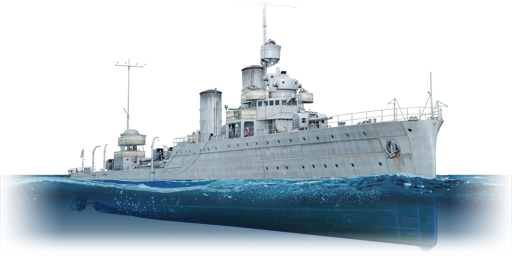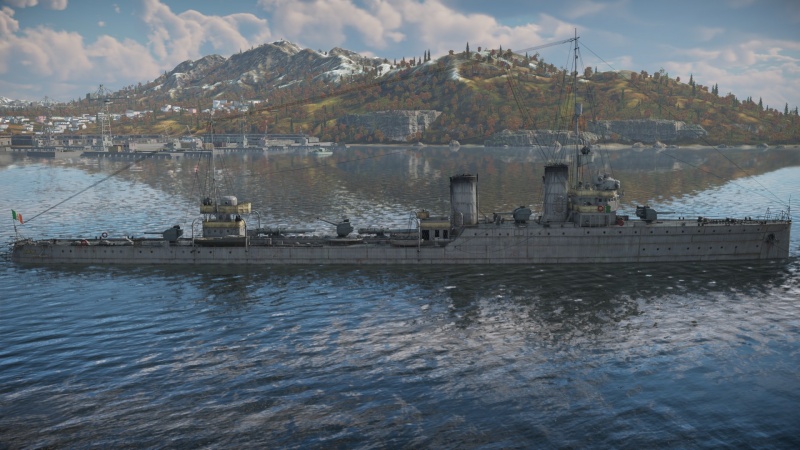Difference between revisions of "RN Leone"
(→Secondary armament) |
Jareel_Skaj (talk | contribs) (+NavalMobility) |
||
| Line 30: | Line 30: | ||
The Leone is somewhat slower than her immediate predecessor, Corazziere, and also has poorer handling and acceleration characteristics due to her greater length and bulk, although they are still acceptable. | The Leone is somewhat slower than her immediate predecessor, Corazziere, and also has poorer handling and acceleration characteristics due to her greater length and bulk, although they are still acceptable. | ||
| − | {{NavalMobility}} | + | {{NavalMobility |
| + | |SpeedForwardStockAB = 57 | ||
| + | |SpeedBackStockAB = 25 | ||
| + | |TurnTimeStockAB = 122.183 | ||
| + | |TurnSpeedStockAB = 40 | ||
| + | }} | ||
=== Modifications and economy === | === Modifications and economy === | ||
Revision as of 19:21, 20 February 2023
| This page is about the Italian destroyer RN Leone. For the other Leone-class destroyer, see RN Tigre. |
Contents
Description
The Leone-class, RN Leone, 1938 is a rank II Italian destroyer with a battle rating of 4.3 (AB/RB/SB). It was introduced in Update "Direct Hit".
The Leone was originally designed as an "esploratore" (scout cruiser). As such, she is significantly larger than contemporary destroyers of the early 1920s and carries a heavy gun armament at the expense of less torpedoes. Despite her design preceding the Comandante Margottini and Corazziere by some 20 years, she is a larger and more heavily armed ship, and thus comes after them in the Italian bluewater tech tree.
General info
Survivability and armour
The Leone has no armour whatsoever other than 12 mm plating partially protecting her main gun mounts.
Her bow main gun ammunition magazine is partially exposed above the waterline. This makes it more vulnerable to penetrating hits, which will detonate the ammunition magazine with immediately fatal results. The stern magazine is below the waterline, and thus less vulnerable.
The Leone has a crew of 206 men, which is slightly smaller than that of the preceding Corazziere.
Mobility
The Leone is somewhat slower than her immediate predecessor, Corazziere, and also has poorer handling and acceleration characteristics due to her greater length and bulk, although they are still acceptable.
| Mobility Characteristics | |||||
|---|---|---|---|---|---|
| Game Mode | Upgrade Status | Maximum Speed (km/h) | Turn Time (s) | Turn Radius (m) | |
| Forward | Reverse | ||||
| AB | Stock | 57 | 25 | ~122.18 | ~216.07 |
| Upgraded | 77 | 34 | ___ | ___ | |
| RB/SB | |||||
| Upgraded | 63 | 28 | ___ | ___ | |
Modifications and economy
Armament
Primary armament
The Leone has a heavy gun armament (for a destroyer) of eight 120/45 Canet-Schneider-Armstrong Mod. 1918/19 main guns. These fire the same shells as the 120/45 OTO Mod. 1926 guns on the Italian reserve destroyer Turbine and have generally identical performance to them as well. They are distributed in four twin mounts, one in the bow, one in the stern, and the other two amidships. Three of these mounts have unlimited traverse, but the one sited between the funnels cannot be traversed fully because of the fore funnel blocking the guns. The guns have a fairly low rate of fire of only 7 rounds/minute maximum with an aced crew.
The 120 mm guns fire HE, HE-DF, and APHE shells. The HE (and identical HE-DF) shells have a large filler for a 120 mm shell at 2.39 kg of TNT, which is significantly more than those of the newer 120 mm HE shells used by the Dardo and Corazziere and even the larger 135 mm HE shells of the Comandante Margottini, Attilio Regolo, and Etna. However, her APHE has less filler than the APHE on those other ships. HE-DF explodes at the range set by the rangefinder, primarily for anti-aircraft usage, but the limited gun elevation makes the main guns quite hard to use in the anti-aircraft role.
| Penetration statistics | |||||||
|---|---|---|---|---|---|---|---|
| Ammunition | Type of warhead |
Penetration @ 0° Angle of Attack (mm) | |||||
| 1,000 m | 2,500 m | 5,000 m | 7,500 m | 10,000 m | 15,000 m | ||
| 120 mm HE Dirompente | HE | 29 | 29 | 29 | 29 | 29 | 29 |
| 120 mm APBC Perforante | APHE | 154 | 121 | 81 | 56 | 41 | 35 |
| 120 mm HE-TF Contro-aerea | HE-TF | 29 | 29 | 29 | 29 | 29 | 29 |
| Shell details | |||||||||
|---|---|---|---|---|---|---|---|---|---|
| Ammunition | Type of warhead |
Velocity (m/s) |
Projectile mass (kg) |
Fuse delay (s) |
Fuse sensitivity (mm) |
Explosive mass (TNT equivalent) (kg) |
Ricochet | ||
| 0% | 50% | 100% | |||||||
| 120 mm HE Dirompente | HE | 850 | 22.11 | 0 | 0.1 | 2.39 | 79° | 80° | 81° |
| 120 mm APBC Perforante | APHE | 850 | 23.15 | 0.025 | 6 | 1.16 | 47° | 60° | 65° |
| 120 mm HE-TF Contro-aerea | HE-TF | 850 | 22.11 | 0 | 0.1 | 2.39 | 79° | 80° | 81° |
Secondary armament
Some ships are fitted with weapons of various calibres. Secondary armaments are defined as weapons chosen with the control Select secondary weapon. Evaluate the secondary armaments and give advice on how to use them. Describe the ammunition available for the secondary armament. Provide recommendations on how to use them and which ammunition to choose. Remember that any anti-air armament, even heavy calibre weapons, belong in the next section. If there is no secondary armament, remove this section.
| Penetration statistics | |||||||
|---|---|---|---|---|---|---|---|
| Ammunition | Type of warhead |
Penetration @ 0° Angle of Attack (mm) | |||||
| 10 m | 100 m | 500 m | 1,000 m | 1,500 m | 2,000 m | ||
| 40 mm HE-F | HEF* | 3 | 3 | 3 | 3 | 3 | 3 |
| Shell details | |||||||||
|---|---|---|---|---|---|---|---|---|---|
| Ammunition | Type of warhead |
Velocity (m/s) |
Projectile mass (kg) |
Fuse delay | Fuse sensitivity (mm) |
Explosive mass (TNT equivalent) (g) |
Ricochet | ||
| 0% | 50% | 100% | |||||||
| 40 mm HE-F | HEF* | 610 | 0.9 | 0 | 0.1 | 55 | 79° | 80° | 81° |
Anti-aircraft armament
An important part of the ship's armament responsible for air defence. Anti-aircraft armament is defined by the weapon chosen with the control Select anti-aircraft weapons. Talk about the ship's anti-air cannons and machine guns, the number of guns and their positions, their effective range, and about their overall effectiveness – including against surface targets. If there are no anti-aircraft armaments, remove this section.
Additional armament
Describe the available additional armaments of the ship: depth charges, mines, torpedoes. Talk about their positions, available ammunition and launch features such as dead zones of torpedoes. If there is no additional armament, remove this section.
Usage in battles
The Leone sacrifices torpedo armament for heavier main gun armament. With a large salvo of eight fairly powerful HE shells, she can deal a substantial amount of damage to opposing destroyers with a single salvo. However, the low rate of fire of the main guns also mean that she cannot really compete in a prolonged duel against fast-firing destroyers (particular the American ones with 5"/38 main guns), and despite her larger size she actually has a smaller crew count than the Corazziere and Comandante Margottini. Furthermore, her partially exposed bow ammunition magazine is a dangerous weakness, especially in close range fights.
Her torpedo armament is very poor, with only four fairly underwhelming 533 mm torpedoes that are not particularly fast and that have a very short range of only 4 km without the torpedo mode installed. It is worth considering not bringing them at all, especially since they are a potential hazard if hit by enemy fire.
It is also worth noting that the Leone has better firing angles towards the stern of the ship than towards the bow. Angling towards the enemy in such a way that the ship fires towards the stern is worth considering, especially since this also exposes the bow ammunition magazine less.
Pros and cons
Pros:
- Large number of main guns
- Large main gun HE shell explosive filler
- Large field-of-fire towards the stern of the ship
- Reasonable penetration and filler for the APHE shell
Cons:
- Low main gun rate of fire
- Inadequate anti-aircraft armament
- Only four torpedoes with a very short range without torpedo mode installed
- Above-waterline bow ammunition magazine
History
Describe the history of the creation and combat usage of the ship in more detail than in the introduction. If the historical reference turns out to be too long, take it to a separate article, taking a link to the article about the ship and adding a block "/History" (example: https://wiki.warthunder.com/(Ship-name)/History) and add a link to it here using the main template. Be sure to reference text and sources by using <ref></ref>, as well as adding them at the end of the article with <references />. This section may also include the ship's dev blog entry (if applicable) and the in-game encyclopedia description (under === In-game description ===, also if applicable).
Media
- Skins
See also
Links to articles on the War Thunder Wiki that you think will be useful for the reader, for example:
- reference to the series of the ship;
- links to approximate analogues of other nations and research trees.
External links
Paste links to sources and external resources, such as:
- topic on the official game forum;
- other literature.
| Ansaldo | |
|---|---|
| Corvettes | |
| Gabbiano-class | RN Gabbiano · Folaga |
| Destroyers | |
| Leone-class | RN Leone · RN Tigre |
| Light Cruisers | |
| Condottieri-class | RN Bartolomeo Colleoni · RN Raimondo Montecuccoli · RN Eugenio di Savoia |
| Heavy Cruisers | |
| Trento-class | RN Bolzano |
| Battleships | |
| Conte di Cavour-class | Novorossiysk* |
| *RN Giulio Cesare before war reparation to the USSR | |
| Italy destroyers | |
|---|---|
| Regia Marina | |
| Aquila-class | RN Aquila |
| Leone-class | RN Leone · RN Tigre |
| Turbine-class | RN Aquilone · RN Turbine |
| Navigatori-class | RN Da Verazzano |
| Dardo-class | RN Dardo |
| Soldati-class | RN Aviere · RN Corazziere · RN Geniere |
| Comandanti Medaglie d'Oro-class | RN Comandante Margottini |
| Marina Militare | |
| Fante-class* | Geniere |
| Indomito-class | Impetuoso |
| * Modified Fletcher-class destroyers | |





